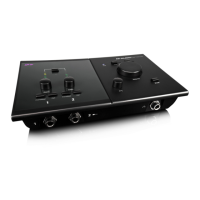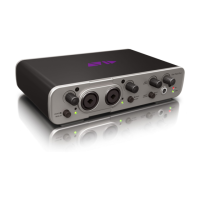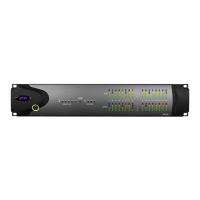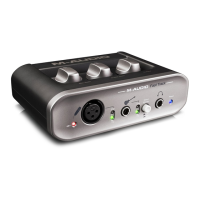Chapter 4: Making Studio Connections 15
Each Input section has three analog input jacks
(the Mic and Line are on a single, combo jack):
Mic For XLR microphone cables.
Line (TRS or TS) For 1/4-inch Tip-Ring-Sleeve or
Tip-Sleeve cables from keyboards, mixers, and
other line-level sources.
DI For 1/4-inch Tip-Sleeve cables from guitar,
bass, or similar sources.
Connecting a Microphone
Mic Cables and Connectors
Use a microphone with an XLR connector to
connect the microphone to the Mbox.
The Mbox can only supply power through a mi-
crophone cable with an XLR connector. If you
are not sure about the phantom power require-
ments for your microphone, refer to your micro-
phone’s documentation or contact the manu-
facturer.
Phantom Power
Some microphones require power to operate.
This power, called phantom power, is supplied ei-
ther by a battery in the microphone, or by a mic
preamp in a mixer or audio interface (such as
Mbox) that can supply power through the mi-
crophone cable.
Most condenser microphones (such as an
M-Audio Solaris) require phantom power to op-
erate. Dynamic microphones (such as a Shure
SM57 or an M-Audio Aries) do not require phan-
tom power to operate, but are not harmed by it.
Front panel analog input connectors
Rear panel analog input connectors
XLR connector
Although phantom power can be used
safely with most microphones, it is possible
to damage some ribbon microphones with
it. Always turn off phantom power and wait
at least ten seconds before connecting a rib-
bon microphone.

